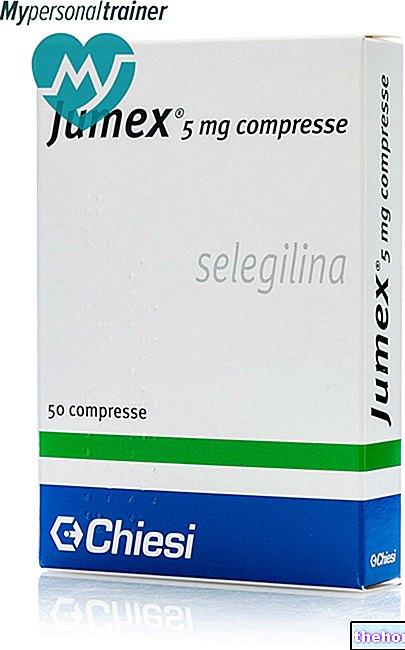Active ingredients: Dihydroergocriptine (? -Dihydroergocriptine mesylate)
MYROL 20 mg tablets
Why is Myrol used? What is it for?
PHARMACOTHERAPEUTIC CATEGORY
Dopamine agonists.
THERAPEUTIC INDICATIONS
Parkinson's disease. Hyperprolactinemia
Contraindications When Myrol should not be used
Hypersensitivity to the active substance or to any of the excipients.
Known or suspected pregnancy and in pediatric age. In relation to its inhibitory effect on milk secretion, the use of the product is also contraindicated during breastfeeding.
Association with erythromycin.
Myrol is contraindicated for long-term treatment and if you have or have had fibrotic (scar tissue) reactions involving the heart.
Precautions for use What you need to know before taking Myrol
The treatment must be carried out under medical supervision.
In headache or parkinsonian subjects with galactorrhea, prolactin-dependent amenorrhea, menstrual disorders or acromegaly, treatment with Myrol can eliminate pre-existing infertility. Women, therefore, who could become fertile, should adopt a method of mechanical contraception. Acromegalic patients with a history of peptic ulcer or with ongoing peptic ulcer, given the absence of experimental tolerability data, should preferably receive alternative treatment. Given the structural similarity with ergoline derivatives, caution is required when Myrol is administered at high levels. doses to patients with a history of psychotic disorders, severe cardiovascular disease, peptic ulcer or gastrointestinal bleeding.
Tell your doctor if you or someone in your family / caregiver notices that you are developing urges or desires to behave in ways that are unusual for you and you cannot resist the urge or temptation to perform certain activities that could harm yourself or others. These are called impulse control disorders and can include behaviors such as gambling addiction, excessive eating or spending, an abnormal, exaggerated sexual desire, or an increase in sexual thoughts or feelings. Your doctor may find it necessary to change or discontinue your dose.
During treatment with dihydroergocriptine the patient should be especially careful while driving or operating machinery. Patients who experience excessive sleepiness should refrain from driving and operating machinery and contact their physician.
Take special care with Myrol if you have or have had fibrotic (scar tissue) reactions involving the heart, lungs or abdomen. Before treatment, your doctor will check whether your heart, lungs and kidneys are in good condition. will also do an echocardiogram (an ultrasound test for the heart) before starting treatment. During treatment, your doctor will pay particular attention to any signs that may be related to fibrotic reactions. If necessary, an echocardiogram will be done. If fibrotic reactions occur, the treatment will have to be stopped.
Interactions Which drugs or foods can change the effect of Myrol
Tell your doctor or pharmacist if you have recently taken any other medicines, even those without a prescription.
The possibility of interactions between α-dihydroergocriptine and psychoactive or hypotensive drugs cannot be excluded.
Particular caution should be taken in patients being treated with other ergot alkaloids or drugs that act on blood pressure in relation to a possible potentiating effect.
Alpha-dihydroergocriptine undergoes hepatic metabolism via the cytochrome P450 isoenzyme CYP3A4 pathway. Therefore, concomitant administration of macrolide antibiotics (such as erythromycin) may increase blood levels of alpha-dihydroergocriptine and its metabolites . An increased risk of side effects may occur as a result.
In case of concomitant administration of drugs that inhibit CYP3A4, the dosage of alpha-dihydroergocriptine should be conveniently reduced.
Warnings It is important to know that:
Effects on ability to drive and use machines
In case of hypotensive reactions, manifested in some patients, especially during the first days of treatment, particular attention must be paid to driving vehicles or operating machinery.
Dihydroergocriptine can cause drowsiness (excessive numbness). For this reason, the patient should refrain from driving or engaging in any activity in which impaired attention could expose himself or others to the risk of serious harm or death (eg. "use of machinery) unless these episodes of sleepiness have already resolved.
Pregnancy and breastfeeding
Myrol is contraindicated in known or suspected pregnancy. In relation to its inhibitory effect on milk secretion, the use of the product is contraindicated during the breast (see "Contraindications").
Important information about some of the excipients
If you have been told by your doctor that you have an intolerance to some sugars, contact your doctor before taking this medicinal product.
Dosage and method of use How to use Myrol: Dosage
Parkinson's disease: the dosage must be modulated according to the response of the individual patient. The recommended starting dose is 5 mg twice a day. Maintenance therapy is usually 60 mg / day and can go up to 120 mg / day, to be achieved gradually with biweekly increases of 5 mg / day.
If Myrol is given in combination with levodopa, with or without a decarboxylase inhibitor, lower doses may be sufficient. Levodopa dose reductions should be made gradually until the optimal therapeutic effect is achieved.
Hyperprolactinaemia: Initial dose: 5 mg twice daily.
Maintenance dose: 10-20 mg twice a day, to be achieved gradually.
Overdose What to do if you have taken too much Myrol
Any overdose can cause hypotension, nausea and vomiting; in this case, intramuscular use of metoclopramide as an antidote is indicated. The patient should be kept in the supine position with blood pressure monitoring.
In case of accidental ingestion / intake of an excessive dose of Myrol, notify your doctor immediately or go to the nearest hospital.
IF YOU HAVE ANY DOUBTS ABOUT THE USE OF MYROL, CONTACT YOUR DOCTOR OR PHARMACIST.
Side Effects What are the side effects of Myrol
Like all medicines, Myrol can cause side effects, although not everybody gets them.
It is important to inform the doctor or pharmacist of any undesirable effect, even if not described in the package leaflet.
During the clinical trials some subjects experienced nausea, vomiting, gastralgia, heartburn, dyspepsia, constipation, dizziness, hypotension, orthostatic hypotension, lipothymia, asthenia, somnolence (excessive numbness), anxiety, headache and tachycardia.
Side effects typically occur during the first few days of therapy and are generally transient. Sometimes some effects are dose dependent and can be overcome with a reduction in dosage.
Rarely, skin rash has been reported. In this case, stop the treatment and consult your doctor.
In the case of treatment associated with L-DOPA, the frequency of side effects such as gastralgia, heartburn, hypotension and headache was increased, and the appearance of edema was also reported.
The following side effects may occur:
- inability to resist the urge to perform actions that could be harmful, which may include:
- strong urge to gamble excessively, despite serious personal or family consequences.
- altered or increased sexual interest and behavior that is of significant concern to you or others, for example, increased sexual desire.
- uncontrollable shopping or overspending.
- compulsive eating (eating large amounts of food in a short period of time) or bulimia (eating more food than normal and more than is needed to satisfy your hunger).
Tell your doctor if any of these behaviors occur so he can decide what to do to manage or reduce symptoms.
Very rare (affects less than 1 in 10,000 people): changes in the valves of the heart and related disorders, eg. inflammation (pericarditis) or fluid leaking into the pericardium (pericardial effusion). The first symptoms may be one or more of the following: difficulty in breathing, shortness of breath, pain in the chest or back, and swelling in the legs. If you notice any of these symptoms you should inform your doctor immediately.
Compliance with the instructions contained in the package leaflet reduces the risk of undesirable effects.
If any of the side effects gets serious or if you notice any side effects not listed in this leaflet, please inform your doctor or pharmacist.
Expiry and Retention
Expiry: see the expiry date indicated on the package.
Warning: do not use the medicine after the expiry date indicated on the package.
The expiry date indicated refers to the product in intact packaging, correctly stored.
Keep this medicine out of the reach and sight of children.
Medicines should not be disposed of via wastewater or household waste. Ask your pharmacist how to throw away medicines you no longer use. This will help protect the environment.
Other information
COMPOSITION
One tablet contains: active ingredient: α-dihydroergocriptine mesylate 20 mg; excipients: lactose; microcrystalline cellulose; croscarmellose sodium; magnesium stearate; povidone.
PHARMACEUTICAL FORM AND CONTENT
Tablets for oral use. 20 tablets 20 mg.
Source Package Leaflet: AIFA (Italian Medicines Agency). Content published in January 2016. The information present may not be up-to-date.
To have access to the most up-to-date version, it is advisable to access the AIFA (Italian Medicines Agency) website. Disclaimer and useful information.
01.0 NAME OF THE MEDICINAL PRODUCT
MYROL
02.0 QUALITATIVE AND QUANTITATIVE COMPOSITION
Tablets
One tablet contains: alpha-dihydroergocriptine mesylate 20 mg.
Drops
100 ml of solution contain: alpha-dihydroergocriptine mesylate 600 mg.
For excipients see 6.1
03.0 PHARMACEUTICAL FORM
Tablets for oral use.
Oral drops.
04.0 CLINICAL INFORMATION
04.1 Therapeutic indications
Parkinson's disease. Hyperprolactinemia
04.2 Posology and method of administration
Parkinson's disease
The dosage should be modulated according to the individual patient's response. The recommended starting dose is 5 mg twice a day. Maintenance therapy is usually 60 mg / day and can go up to 120 mg / day, to be achieved gradually with biweekly increases of 5 mg / day. If Myrol is given in combination with levodopa, with or without a decarboxylase inhibitor, lower doses may be sufficient.
Levodopa dose reductions should be made gradually until the optimal therapeutic effect is achieved.
Hyperprolactinemia
Starting dose: 5 mg twice a day.
Maintenance dose: 10-20 mg twice a day to be achieved gradually.
04.3 Contraindications
Known individual hypersensitivity to the drug.
Association with erythromycin
Known or suspected pregnancy and in pediatric age.
In relation to its inhibitory effect on milk secretion, the use of the product is also contraindicated during breastfeeding.
Evidence of cardiac valvulopathy determined on echocardiogram performed prior to initiation of treatment
04.4 Special warnings and appropriate precautions for use
Dihydroergocriptine can cause drowsiness and other dopamine agonists can be associated with sudden sleep attacks, particularly in patients with Parkinson's disease. Patients being treated with dihydroergocriptine should be advised and cautioned to use caution when driving or operating machinery. Patients who have experienced episodes of somnolence should refrain from driving and operating machinery.In addition, a reduction in dosage or discontinuation of therapy may be considered.
Cases of pathological gambling syndrome, increased libido and hypersexuality have been reported in patients being treated with dopamine agonists for Parkinson's disease.
Treatment must be carried out under medical supervision.
In Parkinsonian individuals with galactorrhea, prolactin-dependent amenorrhea, menstrual disturbances or acromegaly, treatment with Myrol can eliminate pre-existing infertility. Women, therefore, who could become fertile, should adopt a method of mechanical contraception. Acromegalic patients with a history of peptic ulcer or with ongoing peptic ulcer, given the absence of experimental tolerability data, should preferably receive alternative treatment. Given the structural similarity with ergoline derivatives, caution is required when Myrol is administered at high levels. doses to patients with a history of psychotic disorders, severe cardiovascular disease, peptic ulcer or gastrointestinal bleeding.
Pleural and pericardial effusions, as well as pleural and pulmonary fibrosis, and constrictive pericarditis have occasionally been reported among patients treated with dihydroergocriptine, particularly in long-term treatment and at high doses. Patients with pleuropulmonary disorders of an undetermined nature should be carefully examined and 'discontinuation of dihydroergocriptine should be considered.
Particularly for long-term and high-dose treatments, rare cases of retroperitoneal fibrosis have been reported. In order to ensure the recognition of retroperitoneal fibrosis in an early and reversible stage, in this category of patients it is recommended to monitor the typical symptoms of this pathology (e.g. back pain, edema of the lower limbs, alterations in renal function). Dihydroergocriptine therapy should be discontinued if fibrotic changes of the retroperitoneum are diagnosed or suspected.
04.5 Interactions with other medicinal products and other forms of interaction
The possibility of interactions between alpha-dihydroergocriptine and psychoactive or hypotensive drugs cannot be excluded. Particular caution should be taken in patients being treated with other ergot alkaloids or drugs that act on blood pressure in relation to a possible potentiating effect.
Alpha-dihydroergocriptine undergoes hepatic metabolism via the cytochrome P450 isoenzyme CYP3A4 pathway. Therefore, concomitant administration of macrolide antibiotics (such as erythromycin) may increase blood levels of alpha-dihydroergocriptine and its metabolites . An increased risk of side effects may occur as a result.
In case of concomitant administration of drugs that inhibit CYP3A4, the dosage of alpha-dihydroergocriptine should be conveniently reduced.
04.6 Pregnancy and breastfeeding
Myrol is contraindicated in known or suspected pregnancy. In relation to its inhibitory effect on milk secretion, the use of the product is contraindicated during breastfeeding.
04.7 Effects on ability to drive and use machines
Patients on dihydroergocriptine who experience episodes of drowsiness should be advised to refrain from driving or engaging in any activity in which impaired attention could expose themselves or others to the risk of serious harm or death (eg. machinery) unless these episodes of somnolence have already resolved (see section 4.4).
In case of hypotensive reactions, manifested in some patients, especially during the first days of treatment, particular attention must be paid to driving vehicles or operating machinery.
04.8 Undesirable effects
Gastrointestinal disorders
Very common: nausea, gastralgia.
Common: vomiting, heartburn, dyspepsia, dry mouth.
Uncommon: constipation.
Psychiatric disorders
Common: depression, insomnia, agitation.
Uncommon: anxiety, confusion, decreased libido, nightmares, hallucinations.
Nervous system disorders
Common: dizziness, headache.
Uncommon: paraesthesia, tremor, increased sweating.
Ear and labyrinth disorders
Uncommon: tinnitus.
Cardiac pathologies
Common: hypotension, orthostatic hypotension, tachycardia.
Uncommon: chest pain.
Very rare: cardiac valvulopathy (including reflux) and related disorders (pericarditis and pericardial effusion).
Vascular pathologies
Common: rhinitis.
Skin and subcutaneous tissue disorders
Common: skin irritation.
Musculoskeletal and connective tissue disorders
Uncommon: myalgia.
General disorders and administration site conditions
Common: weakness, body weight change.
Uncommon: malaise, anorexia.
Dihydroergocriptine is associated with somnolence.
In patients treated with dopamine agonists, for Parkinson's disease, especially at high doses, there have been reports of pathological gambling syndrome, increased libido and hypersexuality, generally reversible on reduction or discontinuation of treatment.
04.9 Overdose
Any overdose can cause hypotension, nausea and vomiting; in this case, intramuscular use of metoclopramide as an antidote is indicated. The patient should be kept in the supine position with blood pressure monitoring.
05.0 PHARMACOLOGICAL PROPERTIES
05.1 Pharmacodynamic properties
Category: dopaminergic agonist. ATC code: N04BC03
Neuroprotective activity
Alpha-dihydroergocriptine mesylate is a hydrogenated ergot alkaloid which has recently been shown to possess, in addition to a "dopamine-agonist activity, also a" neuroprotective activity.
The neuroprotective action is expressed through a direct action of dihydroergocriptine on the intracerebral content of reduced glutathione, an important endogenous protective factor (scavenger) against the cytotoxicity of highly reactive oxygen free radicals. These free radicals are formed both during aging. brain, in Parkinson's disease and as an effect of levodopa therapy, all events which cause a concomitant reduction in the content of reduced glutathione and the redox index (reduced glutathione / oxidized glutathione) in the brain.
Prolonged treatment with dihydroergocriptine induces a significant increase in brain reduced glutathione, through "activation of antioxidant enzymes, in animal models of Parkinson's disease."
By virtue of this mechanism, dihydroergocriptine protects against neuronal damage induced both in "in vitro" models (aging or excito-toxic stimulus) and in "in vivo" models (aging, ischemia or neuro-toxins).
Dopamine-agonist activity
Alpha-dihydroergocriptine mesylate has a high affinity for dopaminergic receptors against which it has a powerful agonist activity both in the tubero-infundibular or limbic system and in the nigrostriatal system and for these properties it is particularly useful in the treatment of both Parkinson's disease, which is due to degeneration of nigro-striatal dopaminergic neurons, and hyperprolactinemias, since the release of prolactin is regulated by pituitary dopaminergic receptors.
05.2 Pharmacokinetic properties
The drug is well absorbed orally and the maximum plasma level is found on average 1 hour after administration. The drug undergoes hepatic metabolism via the CYP3A4 pathway, the cytochrome P450 isoenzyme, and is eliminated mainly via the biliary route. The biological half-life in humans is 12 hours.
05.3 Preclinical safety data
The oral LD50 was equal to 2555 and 2340 mg / kg in the rat and mouse, respectively. Intravenously, the LD50 in the same species was equal to 112 and 102 mg / kg. In long-term oral toxicity tests in rats and monkeys, alpha-dihydroergocriptine was well tolerated even at doses much higher than the daily therapeutic dose in humans. Teratogenesis and mutagenesis tests gave negative results.
06.0 PHARMACEUTICAL INFORMATION
06.1 Excipients
Tablets
one tablet contains: lactose; microcrystalline cellulose; croscarmellose sodium; magnesium stearate; polyvinylpyrrolidone.
Drops
100 ml contain: sodium saccharin; propylene glycol.
06.2 Incompatibility
No incompatibilities are reported; however, mixing with other drugs is not recommended.
06.3 Period of validity
Tablets: 4 years.
Drops: 3 years.
06.4 Special precautions for storage
No special storage precautions.
06.5 Nature of the immediate packaging and contents of the package
Tablets: aluminum blisters coupled with opaque white PVC
Drops: type III FU dark glass bottle with built-in dropper and aluminum cap.
MYROL - 20 tablets 20 mg
MYROL drops - 1 bottle 30 ml 6 mg / ml
Not all pack sizes may be marketed.
06.6 Instructions for use and handling
No special instructions.
07.0 MARKETING AUTHORIZATION HOLDER
POLICHEM SRL - Via G. Marcora, 11 - 20121 Milan (Italy)
08.0 MARKETING AUTHORIZATION NUMBER
AIC n. 027201058 - "6 mg / ml oral drops, solution" bottle of 30 ml (suspended)
AIC n. 027201060 - "20 mg tablets" 20 tablets
09.0 DATE OF FIRST AUTHORIZATION OR RENEWAL OF THE AUTHORIZATION
June 1989 / June 2000 / June 2005
10.0 DATE OF REVISION OF THE TEXT
December 2008




























